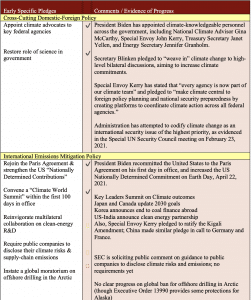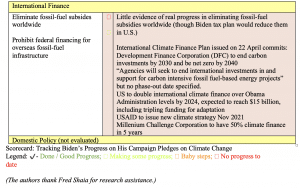Biden’s climate report card: 4 A’s, 2 B’s, 3 Incompletes
By Jeff D. Colgan, Thomas N. Hale, Scott M. Moore | May 21, 2021
 Photo illustration courtesy of Firmbee/Unsplash
Photo illustration courtesy of Firmbee/Unsplash
It is time to give an early take on the Biden administration’s climate diplomacy. Now that we have gotten past the first few months of a Biden presidency, what has his administration’s concerted efforts accomplished? What priorities remain outstanding, and what are in need of further attention as we look toward the upcoming Glasgow Climate Change Conference this November?
To find out, we evaluated the nine internationally-oriented climate pledges made by the Biden campaign during the 2020 presidential election.
(See figure 1.)
In a nutshell, we found that the Biden team has already delivered effectively on four of them, made some progress on two, and taken baby steps or made no real progress on three.

Figure 1.
Where Biden has delivered. The Biden administration has succeeded in transforming the messaging around climate change and US foreign policy, making it clear that climate change is a priority that cuts across different departments to be deeply embedded across all aspects of US foreign policy. The administration has plainly indicated that relationships with major countries and multi-lateral bodies like NATO will all be framed largely by climate goals. Furthermore, the Biden administration has created brand-new government positions related to climate and filled them with qualified and forceful advocates, such as Special Envoy for Climate Change John Kerry. And, obviously, his administration has made climate change a central organizing principle of domestic policy as well. Climate change represents an important focus of major legislation, including the proposed infrastructure bill, and his administration named a National Climate Advisor in the form of Gina McCarthy.
His administration has not only made the the United States rejoin the Paris Agreement; it has set even more rigorous targets (known as Nationally Determined Contributions) than before, pledging to at least halve US carbon emissions by 2030—using 2005 levels as a baseline. It has launched a US-India clean energy initiative that includes tracks for both clean technology development and climate financing; committed to tripling the amount of money given to vulnerable countries to help them fight climate change; and directed agencies to seek ways to phase out fossil fuels from US overseas public financing.
Some progress: investing in technology, and interim targets. All of these moves have effectively created an institutional infrastructure to reduce US emissions, and to persuade other countries to do the same. Unfortunately, even as the Biden administration and key partners around the world—including the European Union and Japan— raise their actions and ambitions, climate science paints an ever-bleaker picture. Recent research suggests that the immense West Antarctic Ice Sheet may be on a path that could ultimately lead to collapse, which would essentially guarantee several meters of additional sea-level rise; new research from the other end of the globe reports the same for the Greenland ice sheet. Meanwhile, the circulation of the North Atlantic Ocean has slowed more than at any other time in the past 1,600 years—a key climate benchmark that could dramatically shift weather patterns, said Nature Geoscience.
Put simply, the world is essentially out of time to formulate a conventional policy solution to the climate crisis. Consequently, addressing it will likely mean that much more ambitious investments are required—in technology to slash emissions, and in helping the poorest adapt to increasingly severe climate effects.
As much as the Biden Administration has succeeded in shifting the focus of both domestic and foreign policy toward climate change, it is also clear that much more must be done to meet the scale of the climate crisis at home and abroad. The headline commitments that the United States announced on April 22, which are based on a 2030 timeframe, must be matched by detailed and verifiable interim targets in specific sectors such as methane emissions and vehicle emissions.
These so-called “sector-level targets” are among the most difficult to meet—which is why US leadership in determining them is so important. Setting detailed interim targets, and being transparent in how close the United States is to meeting them, is important to build trust as the Biden administration attempts to prod other nations to increase their own climate commitments.

Figure 2.
Baby steps or no progress: diplomatic and trade measures, climate finance. Indeed, it is becoming increasingly apparent that the Biden administration will need to do more to encourage, support, and cajole other nations to increase the ambition of their Nationally Determined Contributions. The administration should also consider working with allies to deploy sticks in the form of diplomatic pressure—including even carbon border tax adjustments or other trade measures—for major economies that refuse to adopt ambitious emissions reduction commitments. In addition, there is much that can be done to work with US allies and like-minded nations to make progress in reducing the emissions from areas such as the aviation and shipping industries and reducing deforestation. (See figure 2.)
Another priority should be climate finance—encouraging the private and non-state sectors to set their own emissions reduction targets. Already, organizations such as the United Nations are putting into place programs such as the Race to Zero campaign, which commits participating cities, companies, universities, and investors to reduce their emissions by half by the end of this decade and to net zero by 2050. While many US companies, cities, states, and civil society groups are engaged in such work, there is considerable scope to enhance US participation and mobilize far greater capital resources to support more advanced clean technology—not only in research and development, but also deploying the resulting new technology around the globe and adapting it to local circumstances.
The future. Most important, the Biden administration must keep its eye firmly on the ball when it comes to meeting the climate crisis, no matter what other crises emerge. The climate leadership summit hosted by President Biden last month was a striking display of unity from world leaders, including presidents Putin of Russia and Xi of China—even as growing fears of an armed confrontation over the disputed regions of eastern Ukraine and Taiwan, respectively, seized the minds of national security officials. But there is a real danger that the Biden administration’s focus on climate change could be shaken by a new crisis either at home or abroad.
The bottom line is that the Biden administration is delivering as much or more than many climate advocates could realistically have expected—and yet much more needs to be done to get our climate back on a sustainable path.
Together, we make the world safer.
The Bulletin elevates expert voices above the noise. But as an independent nonprofit organization, our operations depend on the support of readers like you. Help us continue to deliver quality journalism that holds leaders accountable. Your support of our work at any level is important. In return, we promise our coverage will be understandable, influential, vigilant, solution-oriented, and fair-minded. Together we can make a difference.
Keywords: Biden, Kerry, Race to Zero, climate change, climate crisis, climate finance, climate pledges, climate policy, global warming, methane, renewables
Topics: Climate Change


















Most commendable to make every effort to control the build-up of carbon gases in our atmosphere. Unfortunately, this is the wrong culprit, labelled as the climate change CAUSE. Climate change is the EFFECT. The real cause is the massive rise in PEOPLE numbers! Our uncontrolled species, not only increasing at an ever increasing rate, is also using more carbon gas producing processes per capita than ever. We keep kidding ourselves that we are succeeding in this objective. If only we were honest, and admit that our efforts are possibly too late. There is only one solution. Reduce our World’s POPULATION… Read more »